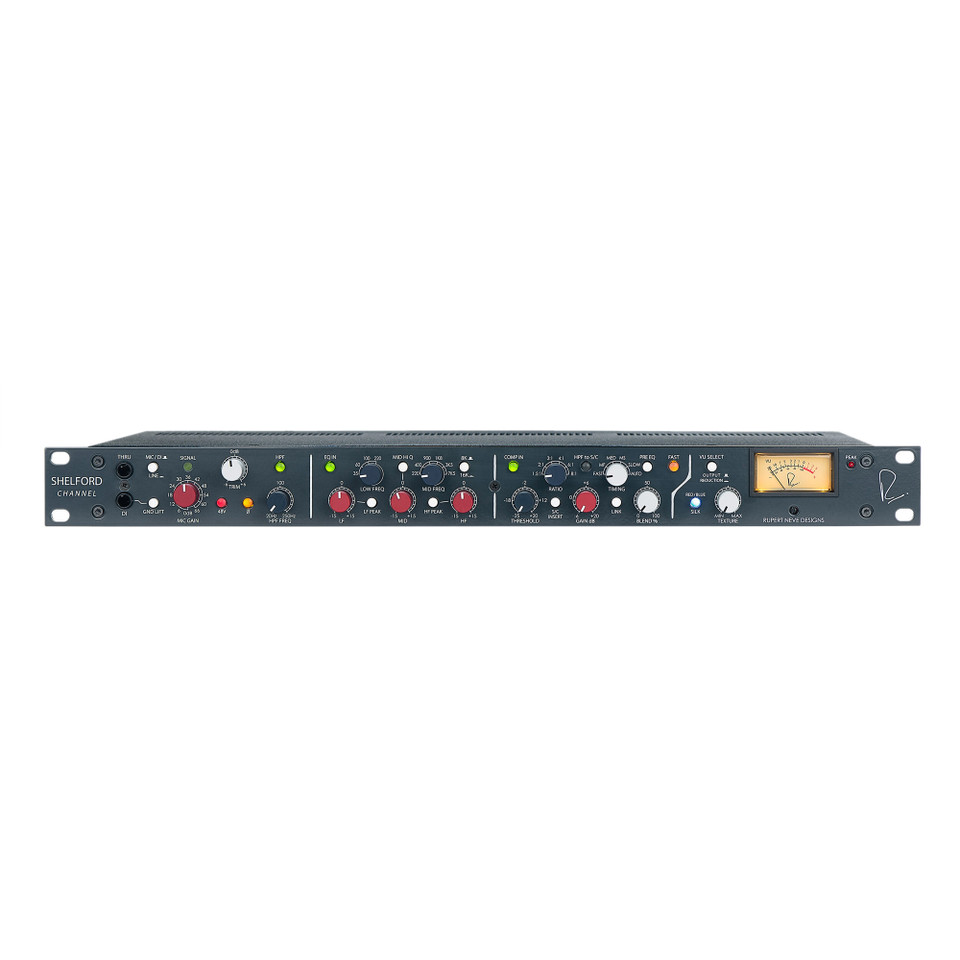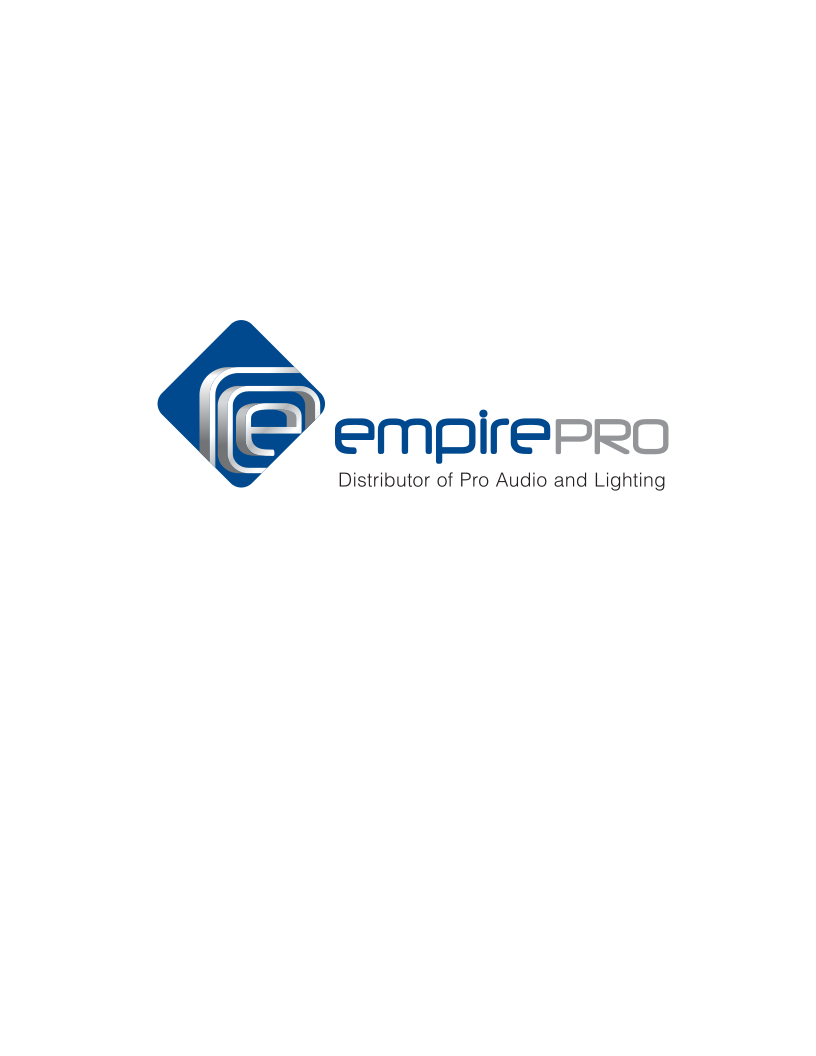Overview
A Whole New Vintage.
The Shelford Channel is built around Rupert Neve’s first new transformer-gain, class-A microphone preamplifier in over 40 years, a “best-of-the-classics” inductor EQ section, a tone-packed diode bridge compressor, the power of variable Silk saturation, a new custom transformer output stage, and twice the operating voltage of vintage designs.
The Input Stage and Transformer Gain Mic Pre
Like Rupert’s designs from his time in Little Shelford , the Shelford Channel’s preamplifier uses a directly-coupled transformer input with gain provided by the custom transformer itself – a first in over 40 years for Rupert Neve. This new custom-designed input transformer, along with its careful integration with the surrounding class-A circuitry, is critical to the Channel’s bold and instantly recognizable character.
Conveniently, the Direct Input uses the same topology as the best-selling RNDI Active Transformer Direct Interface, providing astonishing clarity for high-Z instrument signals, with unparalleled low-frequency response and an incredibly smooth high end.
The Custom Transformer Output
The Shelford Channel has a custom transformer output stage with a balanced standard LINE level output. Additionally, a separate -6dBu XLR output can compensate for high levels of input and Silk harmonic saturation, enabling engineers to fully drive the Shelford to achieve more transformer harmonics without clipping the next device in the chain. Both outputs are active and can be used concurrently.
The LINE output is designed capture a more pristine sound at high levels, avoiding non-linear coloration of the output stage and taking full advantage of the Shelford’s higher voltage design. The -6dB out however is optimized to allow an engineer to drive the full voltage range of the Channel – adding dynamic tone with these same non-linear “colorations” – without clipping most professional interfaces. On drums, vocals, guitars and other instruments, this output lets you easily hit the transformer’s “sweet-spot” of non-linear harmonic content, which can bring a recorded performance to life in a way that other effects can’t.
The “Best-Of” EQ
The Shelford Channel’s 3-band, custom-tapped inductor EQ was inspired by our favorite elements of Rupert’s vintage EQ designs. The low frequency band is designed to produce a creamy, resonant bass response similar to a vintage 1064 – but unlike the vintage modules, the LF band on the Shelford Channel can be used as either a shelf or a peak filter, adding punch, dimension, and control to your low end.
The midrange band is based on that of the 1073, ideal for sweetening vocals and instruments while bringing them forward in a mix, and its proportional “Q” response makes it well-suited for minimizing problematic frequencies. The high frequency band is a hybrid vintage / modern design, blending inductor circuitry with capacitor-based topologies to achieve vintage tones with enhanced control, with the shelf / peak corner switchable between 8K or 16K.
The Diode Bridge Compressor
Like the Inductor EQ and Transformer Gain microphone preamp, the Diode Bridge Compressor in the Shelford Channel is based on the same topologies found in Rupert’s vintage designs – but refined & adapted for the modern engineer.
What is diode bridge compression? Where the VCA compressor found in the Master Buss Processor provides unmatched clarity, the weighty, harmonically rich tonality of diode bridge compression can be essential in pushing key sources like vocals, electric guitars, bass and drums to the forefront of a mix.
By understanding the limitations of vintage units like the legendary 2254, painstaking effort was taken to reproduce the unique tone of these classics while improving the noise floor & accuracy, expanding inflexible time constants, adding full wave sidechain detection for improved dynamic response, and widening the range of threshold and ratio controls.
Delivering the powerful sound of these iconic designs with enhanced flexibility for the modern age, the Shelford’s diode bridge compressor is a dynamic tool equipped to make a statement on virtually any mix or track.
Features
Front Panel
THRU
Passive loop 1/4” output of the DI input signal.
DI
1/4” jack for direct injection (DI) or instrument inputs.
MIC/DI/LINE
Push-button switch that selects the Mic/DI input or line input.
GND LIFT
Push-button switch that separates the DI audio signal ground from chassis ground.
SIGNAL
LED that illuminates GREEN when signal is present and RED when near clip point.
MIC GAIN
12-position rotary switch that controls the microphone preamp gain in 6dB steps.
TRIM
31-detent potentiometer that allows the user to adjust the preamp gain within a range of +/- 6dB.
48V
Push-button switch that illuminates RED when +48V Phantom Power is engaged.
Ø (Polarity)
Push-button switch that illuminates AMBER when engaged and inverts the phase of the input signal.
HPF
Push-button switch that illuminates GREEN when the variable high pass filter is engaged.
FREQ
31-detent potentiometer that allows the user to adjust the cutoff frequency of the variable high pass filter within a range of 20Hz to 250Hz.
EQ IN
Push-button switch that illuminates GREEN when the inductor EQ section is engaged.
LF
31-detent potentiometer that controls the amount of boost or cut for the low frequency band within a range of +/- 15dB.
LOW FREQ
4-position rotary switch that selects the corner (shelf) or center (peak) frequency of the low frequency band.
LF PEAK
Push-button switch that toggles between shelf mode (out) or peak mode (in) of the low frequency band.
MID HI Q
Push-button switch that reduces the Q width of the mid frequency band when pressed in.
MID
31-detent potentiometer that controls the amount of boost or cut for the mid frequency band within a range of +/- 15dB.
MID FREQ
6-position rotary switch that selects the center (peak) frequency of the mid frequency band.
8K/16K
Push-button switch that selects between the two available high frequency shelf/peak frequencies: 8kHz (OUT) and 16kHz (IN).
HF
31-detent potentiometer that controls the amount of boost or cut for the high frequency band within a range of +/- 15dB.
COMP IN
Push-button switch that illuminates GREEN when the diode bridge compressor section is engaged.
THRESHOLD
31-detent potentiometer that controls the compressor threshold range from +20dBu to -25dBu.
RATIO
6-position rotary switch that adjusts the compressor ratio from 1.5:1 to 8:1.
S/C INSERT
Push-button switch that engages the side-chain insert SEND & RETURN jacks on the rear panel for external side-chain processing (ex: EQ).
HPF TO S/C
Push-button switch that illuminates GREEN when the compressor side-chain high pass filter is engaged.
GAIN
31-detent potentiometer that controls the compressor make-up gain within a range of -6dB to +20dB.
TIMING
6-position rotary switch that adjusts the compressor attack and release times. NOTE: Please refer to the Specifications section below for specific attack and release time settings.
LINK
Push-button switch that engages stereo compressor link mode.
PRE EQ
Push-button switch that routes the compressor section ahead of the EQ section when engaged.
FAST
Illuminated push-button switch that speeds up all compressor time constants by 30%.
BLEND %
31-detent potentiometer that controls the wet/dry mix of the compressed signal (wet) to the input signal (dry).
VU SELECT
Push-button switch that toggles between metering the compressor output level (OUTPUT) and gain reduction REDUCTION).
SILK IN
Illuminated push-button switch that toggles through the three available SILK modes: OFF, RED, and BLUE. RED enhances harmonic content in high mid and high frequencies. BLUE enhances harmonic content in low and low mid frequencies.
TEXTURE
31-detent potentiometer that controls the amount of SILK harmonics added within the transformer output stage when SILK is engaged.
PEAK
PEAK LED warns when signal levels are peaking 3dB below clip point.
Rear Panel
POWER
IEC AC power inlet with integrated power switch. 100-240VAC at 50/60Hz. 35 Watts maximum AC power con- sumption.
GROUND LIFT
Slide switch that lifts XLR Pin 1 from chassis ground on the MAIN OUT and the -6dB OUT to help isolate from ground interference.
LINE OUT
Balanced XLR output utilizing a custom Rupert Neve Designs transformer.
-6dB OUT
Balanced XLR output utilizing a lower level, secondary output on the custom Rupert Neve Designs transformer.
SIDE CHAIN SEND
Compressor side-chain insert SEND 1/4” TS jack for connecting to the input of an external processor (ex: EQ).
SIDE CHAIN RETURN
Compressor side-chain insert RETURN 1/4” TS jack for connecting to the output of an external processor (ex: EQ).
LINK
1/4” TS jacks that allow for two Shelford Channel compressors to be linked together for stereo compressor operation. ONLY INTENDED FOR USE WITH OTHER SHELFORD CHANNEL LINK JACKS.
LINE IN
Balanced XLR input that can be utilized for LINE level signals.
MIC IN
Balanced XLR input that can be utilized for MIC level signals.
Specifications
MIC PREAMP
- INPUT IMPEDANCE: 2200 Ohm
- MAXIMUM INPUT LEVEL
- +21.5 dBu from 150Hz to 22kHz
- +8 dBu 20Hz to 22kHz
- NOISE
- Un-weighted, 22Hz - 22kHz, source impedance 150 Ohm balanced.
- Line Out (Unity Gain) -100.9 dBu
- -6dB Out (Unity Gain) -106.6 dBu
- Line Out (+30dB Gain) -91.37 dBu
- Line Out (+66dB Gain) -64.1 dBu
- Equivalent Input Noise -121.37 dBu
- FREQUENCY RESPONSE: 17Hz to 45kHz: +/-0.25 dB
DIRECT INPUT
- MAXIMUM INPUT LEVEL: +8 dBu from 20 Hz to 120 kHz
- NOISE (LINE OUT): -100 dBu (22Hz to 22kHz)
LINE INPUT
- MAXIMUM INPUT LEVEL: +30.5 dBu from 20Hz to 30kHz
- TOTAL HARMONIC DISTORTION AND NOISE
- @ 1 kHz, +20 dBu output level, no load: Better than 0.002%
- @ 20 Hz, +20 dBu output level, no load: 0.05% Typical (2nd and 3rd harmonic)
- NOISE (MAIN OUTPUT)
- Un-weighted, 22Hz - 22kHz, source impedance 40 Ohm balanced, no load.
- -101.1 dBu
- FREQUENCY RESPONSE
- <10 Hz to 110 kHz: +/- 0.25 dB
- 120 kHz: +/- 0.32 dB
- MAXIMUM OUTPUT LEVEL
- 16Hz to 20kHz: +26 dBu
TOTAL HARMONIC DISTORTION AND NOISE WITH SILK ENGAGED
- SILK RED
- MIN TEXTURE @ 100 Hz, +20 dBu input level, no load: 0.0131%, mostly 3rd harmonic (typical)
- MAX TEXTURE @ 100 Hz, +20 dBu input level, no load: 1.66%, mostly 2rd harmonic (typical)
- SILK BLUE
- MIN TEXTURE @ 100Hz, +20 dBu input level, no load: 0.0079%, mostly 3rd harmonic (typical)
- MAX TEXTURE @ 100Hz, +20 dBu input level, no load: 0.941%, mostly 2rd harmonic (typical)
HIGH PASS FILTER
- Continuously variable swept frequency from 20 Hz to 250 Hz.
- Slope: 12 dB/Octave
- EQ NOISE: Un-weighted, 22 Hz-22 kHz: -92 dBu
- SIGNAL PRESENT: Illuminates GREEN when input stage signal level reaches -20 dBu
- OVERLOAD INDICATOR: Illuminates RED when input stage signal level reaches -23 dBu
DIODE BRIDGE COMPRESSOR SECTION
- COMPRESSOR NOISE (BW 22 Hz – 22 kHz)
- 0dB Makeup Gain: -84.5 dBu
- +20dB Makeup Gain: -64.2 dBu
- COMPRESSOR TIMING CONSTANT MEASUREMENTS
- Note: TIMING measurements represent the full range between 1.5:1 and 8:1 ratio and FAST mode
- FAST – Attack 250 μS - 2 mS // Release 100 mS - 200 mS typical
- MED (MEDIUM) – Attack 3 mS - 18 mS // Release 350 mS - 700 mS typical
- MS (MEDIUM SLOW) – Attack 5 mS - 40 mS // Release 600 mS - 1 S typical
- SLOW – Attack 10 mS - 80 mS // Release 800 mS - 1.5 S typical
- AUTO – Attack 5m S - 40m S // Release T1 400-900 mS, T2 1-2 S typical
- PRODUCT DIMENSIONS: 19” (48.3 cm) x 10.5” (26.7 cm) x 1.75” (4.5 cm)
- SHIPPING DIMENSIONS: 24” (61 cm) x 13” (33 cm) x 4” (10.2 cm)
- SHIPPING WEIGHT: 12.25 lbs. (5.5 kg)









